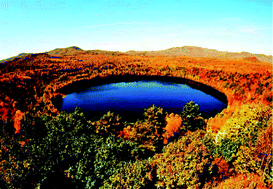A maar lake is an excellent ecosystem to study the atmospheric deposition of pollutants, as its contaminants are primarily by atmospheric deposition. In this study, a sediment core from Sihailongwan Maar Lake, Northeast China, was collected and the historical atmospherically deposited polycyclic aromatic hydrocarbons (PAHs) were analyzed. The concentrations of TPAHs (the sum of the US EPA proposed 16 priority PAHs, excluding naphthalene and pyrene) ranged from 473.9 to 2289 ng g−1 with a slow increasing stage in the deeper sediments and a sharp increasing stage in the upper sediments. The input rate of TPAHs, especially that of PAH9 (the sum of fluoranthene, benzo(a)anthracene, chrysene, benzo(b)fluoranthene, benzo(k)fluoranthene, benzo(a)pyrene, indeno(1,2,3-cd)pyrene, dibenzo(ah)anthrathene, and benzo(ghi)perylene), correlated well to the Chinese historical socioeconomic data. This indicates that sediment PAHs were mainly derived from human activities and PAH9 can be regarded as a better indicator of the local socioeconomic development. Source identification suggested that PAHs were originated primarily from mixed sources (e.g., coal and biomass burning and petroleum combustion), except for perylene which was mostly of diagenetic origin. In addition, the down-core PAHs profile clearly illustrated that PAHs sources in Northeast China experienced a transformation from low- and moderate temperature to high-temperature combustion processes, especially after the late 1980s. Additionally, an ecological risk assessment using two redefined biological thresholds (TEQERL and TEQERM) indicated that most of the PAHs measured in the present sediment core would not cause an immediate toxic effect; only FLU and PHEN are a potential source of concern for biological impairment.


 Please wait while we load your content...
Please wait while we load your content...